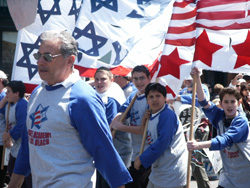

 Emily Jacir is one of the most prominent members of a generation of artists who are based in the U.S., but have used their first-generation nationalities as a tool to question how such identities are constructed, and what particular experience they bring to bear on the creative role of the artist within society. A Palestinian-American holding a U.S. passport, Jacir has found herself in the relatively privileged position of being a member of an embattled, stateless people, who nonetheless can enter leave and enter the U.S. and Israel, and has at times even been permitted to travel in Palestine and the occupied territories. Such a privilege, however conditional and short-lived, became the core of Jacir’s best-known work, Where We Come From (2003), in which she fulfilled the personal requests of several dozen Palestinian exiles bearing a wide range of identification papers, from U.S. and Israeli passports to those living in closed areas or refugee camps. These favors, which probably would not be possible today, ranged from having lunch at a favorite fish restaurant to placing flowers on somebody’s mother’s grave, and were documented both in photo and text, providing an inside view of life in a place where freedom of movement is strictly rationed.
Emily Jacir is one of the most prominent members of a generation of artists who are based in the U.S., but have used their first-generation nationalities as a tool to question how such identities are constructed, and what particular experience they bring to bear on the creative role of the artist within society. A Palestinian-American holding a U.S. passport, Jacir has found herself in the relatively privileged position of being a member of an embattled, stateless people, who nonetheless can enter leave and enter the U.S. and Israel, and has at times even been permitted to travel in Palestine and the occupied territories. Such a privilege, however conditional and short-lived, became the core of Jacir’s best-known work, Where We Come From (2003), in which she fulfilled the personal requests of several dozen Palestinian exiles bearing a wide range of identification papers, from U.S. and Israeli passports to those living in closed areas or refugee camps. These favors, which probably would not be possible today, ranged from having lunch at a favorite fish restaurant to placing flowers on somebody’s mother’s grave, and were documented both in photo and text, providing an inside view of life in a place where freedom of movement is strictly rationed.
For the Taipei Biennial, Jacir premieres a video that was originally shot in May 2002, at the annual Israeli Day parade. For Jacir, the return to New York that particular spring coincided with the very recent experience of having been in Beirut for more than a month, while it was being shelled by Israel in a campaign known as Operation Defensive Shield. Because of the volatility of the Israel-Palestine situation, the Israeli Day parade is inevitably accompanied by protesters allied with Palestinian rights groups. Our point of view is in the middle of this second group, from where we cannot see the protest signs, but we can occasionally hear their chants. What we get, mostly, are the reactions of the people in the parade as they turn to look in our direction.
At three and a half minutes, Jacir’s video is quite short, but it makes some crucial points. The first is that if one belongs to a marginalized group, then the symbols of one’s exclusion from power can be found everywhere one looks – particularly in the faces of the paraders, who respond to the Palestinian group as if it were something distasteful, like garbage. Another point underscores the depth and pervasiveness of the U.S.-Israel alliance, which is most pervasively symbolized by the constant mingling of U.S. and Israeli flags by the marchers.
The video’s saving grace is a towheaded young boy from Boca Raton, who stands at a point where the parade has momentarily stopped Staring in our direction a the sound of “Free Palestine! Free Palestine!”, he is puzzled, even confused. Although his indecision lasts only a few moments until the parade starts up again and his elders urge him forward, the boy’s look of curious uncertainty comes across as a momentary beacon of hope.